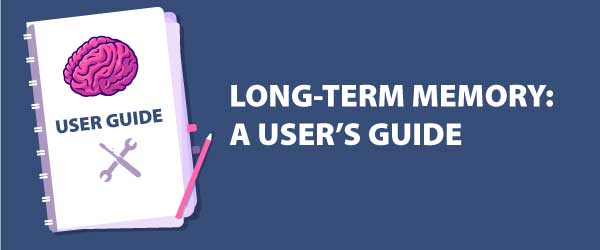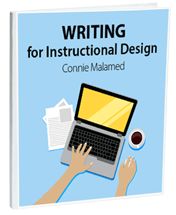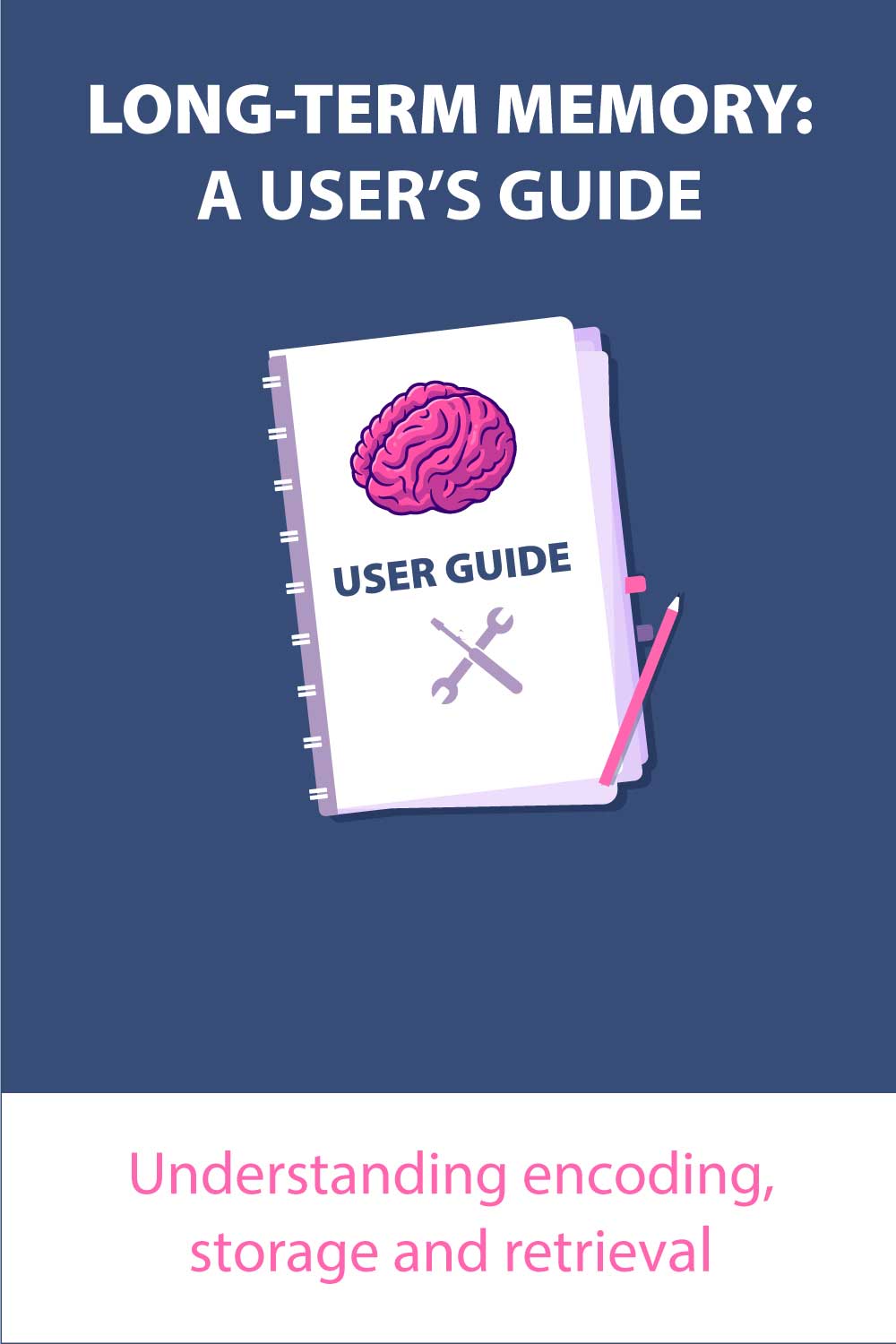
When you’re designing learning experiences, long-term memory is the ultimate destination. It’s the promised land—where you want newly learned skills and information to integrate with a person’s network of knowledge. So shouldn’t we be more familiar with the characteristics and dynamics of long-term memory? I think we need a user’s guide.
Overview of Long-term Memory (LTM)
- Long-term memory is a hypothetical construct. You won’t find a matching structure in the brain. But it’s helpful to think of long-term memory as a dynamic yet permanent store of information.
- Researchers have found regions in every lobe of the brain that store and retrieve memories of facts and events.
- We are usually referring to long-term memory when we talk about remembering something.
- Long-term memory encompasses three operations: encoding, storage and retrieval. These are explained below.
- It’s not just an archive of information and knowledge. LTM provides the wealth of information that we need to understand the world by bringing relevant knowledge into working memory as it’s needed.
Types of Long-term Memory
- Cognitive psychologists think of long-term memory as divided into two broad types. Explicit memory, also called declarative memory, refers to our conscious memories. Implicit memory, also called non-declarative memory, is unconscious. It consists of memories below our conscious awareness.
- Explicit memory (the conscious kind) can be theoretically organized into two types. Semantic memory refers to facts and knowledge about the world. Episodic memory refers to the memory of personal experiences.
- There are several types of implicit memories (the unconscious kind). Most relevant to training is procedural memory. This is our memory for doing things that usually require action. When we use a mouse on the computer or enter a phone number we are not consciously aware of the memories that enable us to perform these skills.
Capacity, Duration and Speed
- No one knows how long information can last in long-term memory. The duration could be indefinite. Think of the older people you know who are experts in their field or who remember details of their childhood. Some information appears to last forever.
- It is equally unknown how much information long-term memory can store. In practical terms, long-term memory seems to have an infinite capacity because it never gets used up.
- The time it takes to access information in long-term memory is thought to be 200 milliseconds or .200 seconds.
- Compare the capacity and duration to that of working memory. It’s quite different!
Encoding to LTM
- Encoding is the process of transforming information to store it in long-term memory. There are varied strategies that instructional designers and learners can use to improve encoding. See the Strategies below.
- Information in long-term memory is most likely stored in network-type structures called schemas. Schemas are an efficient way to organize interrelated concepts in a meaningful way.
- When we learn or experience something new and connect it with previously stored information, the process is known as assimilation.
- Sometimes we learn something new or have experiences that don’t fit in with existing schemas. We then alter existing schemas or create new ones in a process cognitive psychologists call accommodation.
Retrieval from LTM
- Retrieval is the process of activating and using information from long-term memory. A retrieval cue is any stimulus that helps us recall information from long-term memory.
- Some cognitive psychologists think that not being able to remember something is more a failure of not having the right cue than the fact that the information is not present in long-term memory.
- Recognition memory is almost always better than recall. Recognition involves determining whether you’ve seen something before. With recall, you have to generate the remembered information.
- Memories are more than a simple construction of recalled information. Rather, attitudes, beliefs and previous experiences influence what we recall. Memories are reconstructed events.
Strategies to Enhance Encoding and Retrieval
Learning experience designers can use strategies that enhance encoding and retrieving information and skills, as explained below.
- Use elaboration strategies to facilitate the transfer of information into long-term memory. Some elaboration strategies include: thinking of related ideas or examples of the content, mentally tying the information together or creating a mental image of the information. Course designers and instructors can encourage this behavior.
- Use the same type of elaboration for encoding that learners will need for retrieval.
- Make purposeful connections and associations with prior knowledge to improve transfer to long-term memory.
- Organize information by categorizing it into subsets to facilitate storage and retrieval. Many people do this spontaneously and instructional designers spend a great deal of effort at organizing information into meaningful chunks.
- Provide distributed practice across multiple study sessions rather than concentrating the same amount of practice into one session. This allows information to consolidate into memory over time, improving retention.
- Help learners associate facts with a personal experience to improve recall. Pairing semantic memories with episodic memories facilitates learning.
- Use retrieval practice when memorization is important for a job role.
References
- Gagne, Ellen. The Cognitive Psychology of School Learning. Allyn & Bacon, 1997
- Goldstein, E. Bruce. Cognitive Psychology: Connecting Mind, Research and Everyday Experience. Wadsworth Publishing, 2010.
- Sternberg, Robert J. Cognitive Psychology. Wadsworth Publishing, 2011.
- Smith, Patricia L. and Tillman J Ragan. Instructional Design, Wiley, 2004.



Hi Neisha,
Thanks for sharing the technique that works for you. I’m sure others will benefit from it too.
Best,
Connie
Hi Connie,
You have proven to be a reliable and informative source for many including myself. I’m a student who’s new to Instructional Design. I find your Strategies to Enhance Encoding and Retrieval informative. Particularly #24, distributing practice across multiple sessions to improve retention.
Recently, I made a conscious effort to try to manage my time better by using the Pomodoro technique. It was developed by Francesco Cirillo in the 1980s and the practice suggests that tasks are worked on in 25 minute segments with short breaks in between each segment and then a longer break after four consecutive 25 minute segments.
I used this approach to prepare for a self study exam and found it to be quite effective. Essentially, it’s the same approach by a different name. 🙂 I will be sure to consciously incorporate the other strategies in my everyday activities.
Ms. Malamed,
I recently started my journey in obtaining my Masters degree in Instructional Design and Technology. While I have known there are blogs out there I have recently started following blogs to help further my knowledge of IDT.
This week in our class we are focusing on learning processing and that “all learning involves forming associations between stimuli and responses” (Ormrod, Schunk, & Gredler, 2009, p.49). Your “User’s Guide to Long Term Memory” has helped me to understand this better. Our reading this week showed that “LTM depends on frequency and contiguity” (Ormrod, Schunk, & Gredler, 2009, p.68). Personally, for me, “the more often that a fact, event, or idea is encountered, the stronger is its representation in memory” (Ormrod, Schunk, & Gredler, 2009, p.68). Whether it’s auditory or visual the more contact I have with the information the more likely I am to be able to remember it for the long term.
Until now I did not realize there were so many different types of memory. Along with short-term and long-term memory there are also episodic, semantic, declarative and procedural memories which we reviewed this week. Episodic memory includes information that is personal that an individual can relate to a specific time and place. A good example of episodic memory is me remembering exactly what happened Easter of 2007 because I had to put my dog of 19 years to sleep that same weekend. Semantic memory “involves general information and concepts available in the environment and not tied to a particular context” (Ormrod, Schunk, & Gredler, 2009, p.68) Semantic memory is represented best by the specific facts learned, for example learning the words to the “Pledge of Allegiance”. Procedural memory is memory used for learning a new language such as Italian. The best way to learn is constant repetition. And finally there is declarative memory which “involves remembering new events and experiences” (Ormrod, Schunk, & Gredler, 2009, p.69).
Up until know I feel I have been naïve in regards to memory. I though that memory was just memories and did not realize that there was so many different categorizations for memories. Understanding these different types of memory will assist in the encoding process and improve “memory because items are linked to one another systematically” Ormrod, Schunk, & Gredler, 2009, p.70).
I’m looking forward to more great articles in the future!
Heather
References:
Ormrod, J., Schunk, D., & Gredler, M. (2009). Learning theories and instruction (Laureate custom edition). New York: Pearson.
Thank you Ms. Malamed for this LTM user guide. I am just beginning a formal education in Instructional Design & Technology and this was a great overview to why we need to understand what long term memory is. There are so many ideas and strategies to provide effective learning that it is exciting and confusing all at the same time. The goal: finding a way to create and present meaningful information so it will find a final resting place in a person’s long term memory. When you have designed courses in the past how have you encouraged the elaboration process? Are there specific techniques you have that help to pair the semantic memories with the episodic memories the learner may have?
Thanks again for this information. I look forward to following your blog.